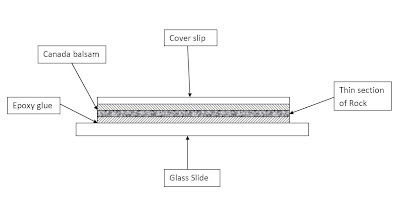 |
| thin section of Gabbro - image from wikipedia |
The procedure adopted in preparing thin sections is explained below.
1. The sample to be sectioned and is determined and the direction of the cut is selected such that it is cut across structures such as layering, foliation, cleavages etc.
2. A rectangular slice having a size of about 3x2x0.5 cm is cut using a diamond wheel.
3. One surface of the slice is polished using Carborundum powder from coarse to fine varieties.
4. The polished specimen is mounted onto a glass slide, polished side down using epoxy glue. (Care should be taken to avoid air bubbles)
5. The other side of the rock specimen is ground and polished using carborundum powder to bring the thickness of the section to 0.03mm.
6. The cover slip is fixed onto the polished section using Canada Balsam. (The cover slip protects the thin section)
The following diagram depicts the prepared thin section (thicknesses are exaggerated for clarity)
 |
| thin section |
This method is used for preparing thin sections of hard rocks. In order to prepare a thin section from a soft rock, first the rock must be strengthened using a glue, and the same procedure must be followed.
Sand grains can be directly mounted on Canada Balsam and polished if necessary before covering with a cover slide. This method is used to observe the interior of individual grains of sand.

No comments:
Post a Comment